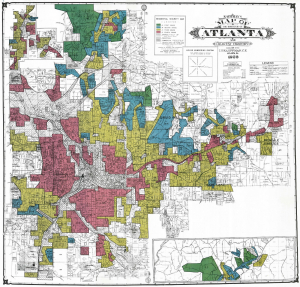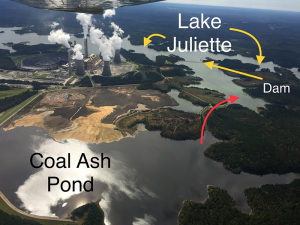Environmental Justice in Georgia: History, Current Injustices, and Progress
By: Thora Middleton, Office of Sustainability Initiatives Intern, July 2020

Atlanta, Georgia is the second largest majority black metropolitan area in the country. The average household income in Atlanta is $98,757, but there is a staggering poverty rate of 21.63% (World Population Review, 2020). Atlanta is a segregated city, both racially and economically. In the 1930s, the Home Owner’s Loan Corporation and the Federal Housing Administration encouraged redlining practices that explicitly marked minority neighborhoods as risky investments and discouraged bank loans, mortgages, and insurance there (Kruse, 2019). In the 1950s and 1960s, the city of Atlanta created the Interstate highway system as a way to separate the black and white communities. More specifically, Interstate 20, the east-west corridor that connects with I-75 and I-85 was deliberately placed as a boundary between the two communities (Kruse, 2019).
In 2012, Atlanta-based environmental law nonprofit, GreenLaw, published a report on the intersection of pollution and demographics in the Atlanta Metropolitan Area, which included 14 counties. They analyzed publicly available data to identify eight types of air, water, and land pollution, which were then cross-referenced with seven demographic characteristics to see how pollution and demographics were related. The report very clearly showed that “race is the characteristic with the strongest correlation to pollution” (Deganian & Thompson, 2012). The divided history of our city and region, and the resulting difference in exposures to environmental harm by race, highlight why all community actors must keep environmental justice at the forefront of environmentalism in order to see the injustices and to work intentionally to right them.
If we go outside the Atlanta area, we see the impacts of environmental injustices in middle and southern Georgia communities as well. Brunswick, a coastal city, has been highlighted in the news recently. This city was the home of Ahmaud Arbery, a black man who was pursued while jogging and was ultimately murdered by armed white men. Brunswick is 56.6% black and is home to four superfund sites in its small 25 square mile area (EPA, 2020) (US Census Bureau, 2019). Superfund sites are designated by the Environmental Protection Agency (EPA) as polluted locations that require a long-term clean-up of hazardous and toxic material contaminations. There are 22 superfund sites in the state of Georgia. Another three superfund sites can be found in Albany, Georgia, which has a population that is 71.6% black. In fact, 14 out of 22 superfund sites are in cities where the majority of the population is black (EPA, 2020) (US Census Bureau, 2019). Since Georgia has a majority white population, this is cause for concern.
Georgia’s environmental injustices span issues of air pollution, food access and quality, chronic water quality issues, hazardous and solid waste sites, polluting energy generation and more. Vital to the public health of many communities of color is restoring the health of polluted water ways. The communities around Proctor Creek in West Atlanta suffer from recurring flooding and sewer overflows, which puts them at risk of being exposed to harmful pathogens. As communities in West Atlanta have seen more development and gentrification, more community members are encountering these environmental hazards, amplifying the calls for cleaning up these waterways and for better stormwater management (EPA, 2019).
These amplified voices are being heard more and more. In 2013, Proctor Creek was designated by the Urban Waters Federal Partnership to be a priority Urban Waters location. The Partnership has promoted community-led efforts for economic, social, and ecological revitalization of communities along this important waterway (EPA, 2019). The advocacy of local communities has also led to recognition of these issues by some local governments. In 1996, Fulton County adopted the EJ Comprehensive Plan Policies to encourage EJ considerations when permitting sources of pollution and other infrastructure projects (Deganian & Thompson, 2012) (Fulton County, 2016). In 2010, the Fulton County Board of Health started an Environmental Justice Initiative to further connect environmental and public health needs for the county’s residents. In 2016, the county published its Comprehensive Plan for 2035 that outlines EJ policies adopted over the past two decades and that set necessary steps the county’s Environmental Justice Initiative will take throughout community development review processes (Fulton County, 2016). Other municipalities in the state incorporate some aspects of environmental justice and community engagement into the review of development projects, but most do not have mechanisms in place for these considerations when making zoning and permitting decisions.

In the most recent state legislative session, multiple bills to protect water and air quality were passed by both chambers and sent to Governor Kemp for ratification or veto. SB-123 raises the price of dumping coal ash, which is a toxic waste material left behind from the burning of coal, was quickly signed it into law. Other bills, many of which were proposed by representatives and senators from Brunswick, targeting coal ash management to protect human and environmental health were proposed this year but were voted down or stalled in the legislature (Nolin, 2020). Another bill proposed this year, SB 426, passed both chambers and would require companies to disclose any ethylene oxide leaks that violate their permit within 24 hours. Ethylene oxide is a gas that is used in medical sterilization and has been linked to increased rates of cancer. Ethylene oxide exposure was flagged to the EPA by its National Environmental Justice Advisory Council in 2019 because of its impacts on workers and on communities surrounding facilities that use the chemical. This bill is waiting on Governor Kemp’s signature (Nolin, 2020).
Are you wondering how you can become an environmental justice advocate in Georgia? You can sign up to help clean up the Chattahoochee River, South River and Flint River. You can support and donate to local organizations that work for EJ, like Partnership for Southern Equity, West Atlanta Watershed Alliance, or Georgia WAND. You can also advocate for local policies that EJ organizations and local communities most affected are supporting. Reduce your individual contributions to polluting industries, e.g. by reducing plastics use, and be sure to recycle and safely dispose of toxic materials so they don’t end up polluting ecosystems and vulnerable communities. Consider becoming a trained citizen scientist to help track pollutants in watersheds. Georgia may have racial and economic divisions at the root of many environmental injustices in the state, but we all have a role to play in ensuring that the historical decisions which established these divides do not determine the future and health of communities and of Georgians of all races.
Sources Cited:
Deganian, D. & Thompson, J. (March 2012). The Patterns of Pollution: A Report on Demographics and Pollution in Metro Atlanta [PDF]. Retrieved from https://greenlaw.org/pdf/PatternsofPollutionFINALGreenLaw3-26-2012.pdf
Environmental Protection Agency (EPA). (2019, July 25). Urban Waters and the Proctor Creek Watershed/Atlanta (Georgia). Retrieved from https://www.epa.gov/urbanwaterspartners/urban-waters-and-proctor-creek-watershedatlanta-georgia
Environmental Protection Agency (EPA). (2020, June 3). Search for Superfund Sites Where You Live. Retrieved from https://www.epa.gov/superfund/search-superfund-sites-where-you-live
Fulton County: Department of Planning and Community Services. (2016, October 5). 2035 Fulton County Comprehensive Plan [PDF]. Retrieved from https://www.dca.ga.gov/sites/default/files/fulton_county_comp_plan_2016_0.pdf
Kruse, K.M. (2019, August 14). What does a traffic jam in Atlanta have to do with segregation? Quite a lot. The New York Times Magazine. Retrieved from https://www.nytimes.com/interactive/2019/08/14/magazine/traffic-atlanta-segregation.html
Nolin, J. (2020, July 7). Ga. legislative debates over coal ash, air pollution turned toxic at times. Georgia Recorder. Retrieved from https://georgiarecorder.com/2020/07/07/ga-legislative-debates-over-coal-ash-air-pollution-turned-toxic-at-times/
United States Census Bureau. (2019). QuickFacts: Georgia. Retrieved from https://www.census.gov/quickfacts/GA
World Population Review. (2020). Atlanta, Georgia Population 2020. (2020). Retrieved from https://worldpopulationreview.com/us-cities/atlanta-ga-population
